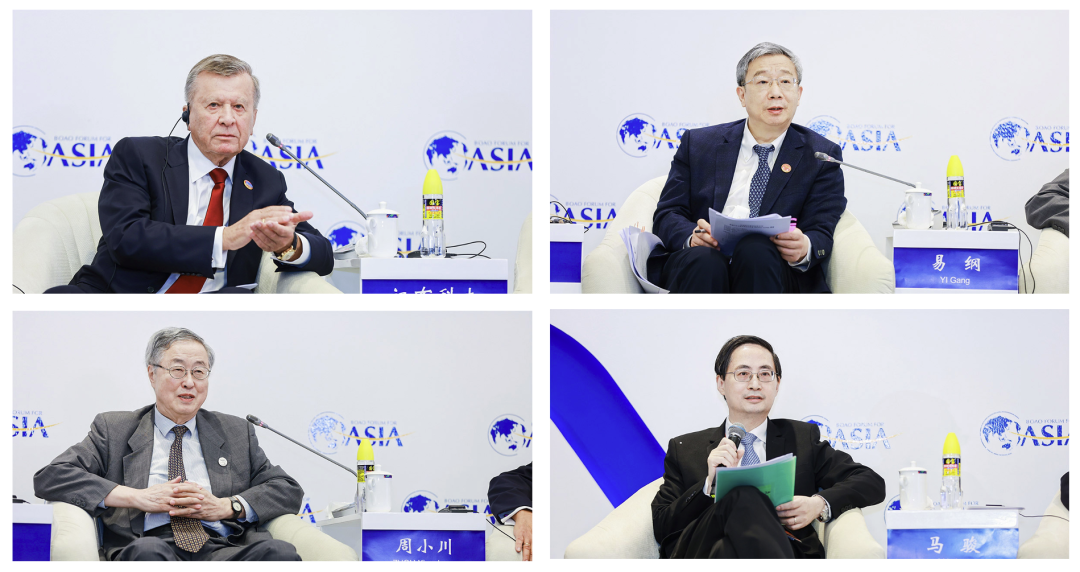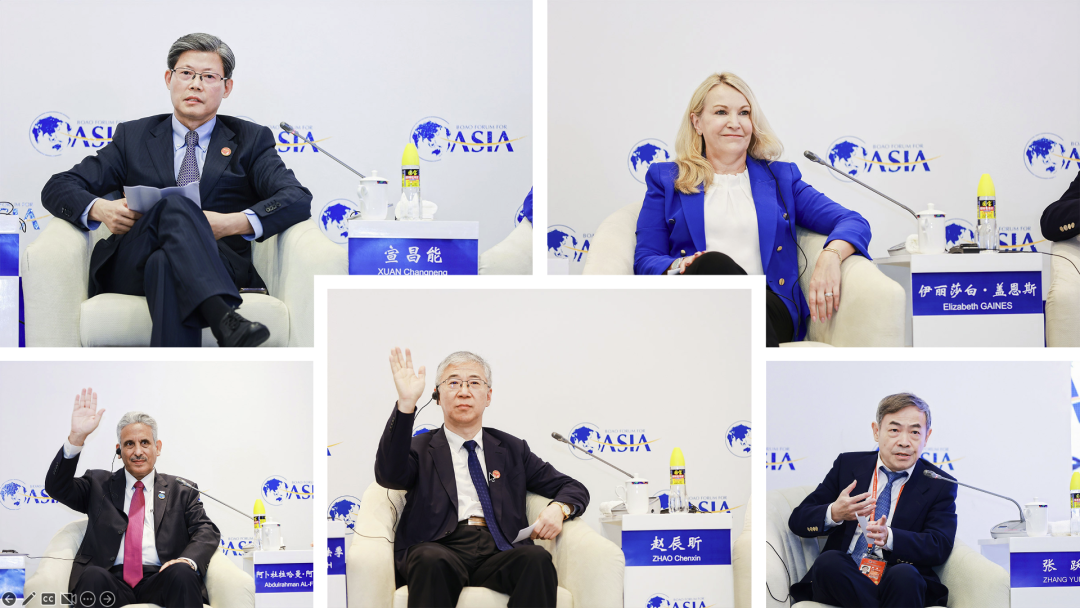Ma Jun chairs the Seminar on Carbon Neutrality at Boao Forum for Asia; Zhou Xiaochuan, Yi Gang, Xuan Changneng, Zhao Chenxin deliver speeches


Introduction
On March 29, during the Boao Forum for Asia Annual Conference 2023, Dr. Ma Jun, Chairman of the Green Finance Committee (GFC), China Society for Finance and Banking, President of the Institute of Finance and Sustainability (IFS), chaired the seminar “Carbon Neutrality: Challenges and Breakthroughs”. The seminar focused on the difficulties and challenges faced by China and other countries in achieving carbon neutrality, as well as the responses of government authorities, financial institutions, and corporate entities. Guest speakers at the seminar included Zhou Xiaochuan, Vice Chairman of Boao Forum for Asia, Vice Chairman of the 12th National Committee of the Chinese People’s Political Consultative Conference (CPPCC), former Governor of the People’s Bank of China(PBC); Viktor Zubkov, former Prime Minister of Russia, Chairman of Gazprom; Yi Gang, Governor of People’s Bank of China (PBC); Xuan Changneng, Deputy Governor of PBC; Zhao Chenxin, Vice Chairman of the National Development and Reform Commission (NDRC); Abdulrahman Al-Fageeh, CEO of Saudi Basic Industries Corporation (SABIC); Elizabeth Gaines, Global Green Ambassador and Non-executive Director at Fortescue Metals Group (FMG); and Zhang Yue, Chairman of Broad Group.
Opening speech
In his opening speech, Ma Jun pointed out four major challenges in the global process of carbon neutrality. Firstly, carbon neutrality, a long-term goal of governments, conflicts with short and medium-term policy considerations, such as energy security, inflation prevention, employment stability, and epidemic control. To address these conflicts, countries should set reasonable short, medium and long-term decarbonization targets and introduce balanced policies. Secondly, it is still challenging to combine and coordinate various policy tools to promote carbon neutrality, especially between price tools like carbon markets and carbon taxes, and non-price tools such as specific industrial decarbonization targets and incentives. Thirdly, green finance has not yet effectively supported the low-carbon transition of carbon-intensive industries, and a financial framework is needed to mobilize social capital for the transition. Fourthly, most high-carbon companies are willing to transit, but they lack knowledge of transition roadmap, including selecting appropriate decarbonization technologies, setting scientific carbon reduction targets, conducting carbon accounting and disclosure, and using transition finance tools. Ma Jun suggested that PBC could consider drawing on the experience of the “carbon-reduction supporting tools”, and establish “transition finance supporting tools” to provide low-cost financing for eligible transition activities.
Guests’ insights
When it came to various policy tools for achieving carbon neutrality, namely price tools and non-price tools, Zhou Xiaochuan noted that all these policy tools play a part in promoting decarbonization, and are not necessarily inferior or superior to each other. However, in reality, governments often have multiple policy goals, and sometimes these goals may conflict with each other. Therefore, it is necessary to find an optimal balance between these goals and tools. Price and non-price tools cannot be separated, as price tools are more effective in some cases, and non-price tools can achieve similar effects with an optimized design. Yi Gang likened different policy tools to “carrots” and “sticks”. For most companies, carbon taxes and carbon markets are “sticks”, while the “carbon-reduction supporting tools” launched by PBC and other green development incentives are “carrot”. Both types of tools can be effective in promoting decarbonization.
Zhao Chenxin explained that in energy structure transformation, the NDRC is working on three fronts to better deal with the relations between “establishing the new” and “abolishing the old”. First, vigorously develop renewable energy. China planned to build solar and wind power stations with a capacity of 450 million kilowatts in desert, Gobi and barren areas. The installed capacity of renewable energy has already reached 1.2 billion kilowatts, surpassing any other country and demonstrating China’s firm determination to achieve carbon neutrality. Second, promote the clean use of coal resources. China has abundant coal reserves but limited oil and gas reserves, so the country is actively pursuing coal-fired power plants transformation, focusing on energy conservation and carbon reduction, flexibility enhancement, and heating transformation.. Third, develop a new power system for energy supply security and stability. Abdulrahman Al-Fageeh noted that joint action by energy providers, chemical producers, and end-users is also required to achieve low-carbon transition and carbon neutrality in the chemical industry. A balance between short, medium and long-term goals can be made through the 4Rs, namely Reduce (reduce usage), Recycle (recycle resources), Remove (carbon capture technology) and Reuse (reuse materials). Viktor Zubkov introduced Russia’s policies on tackling climate change and emphasized the importance of China-Russia energy cooperation in promoting low-carbon development.
Regarding the role of the financial market in promoting low-carbon transition and carbon neutrality, Yi Gang stated that PBC has been actively developing green finance for years to support green development and actively participating in international cooperation, and has achieved significant results.. As of the end of 2022, China’s green loans surpassed RMB 22 trillion, accounting for about 10% of total loans, and the balance of Green Bonds exceeded RMB 2.5 trillion. Internationally, PBC and the US Treasury Department jointly chaired the G20 Sustainable Finance Working Group, completing important achievements such as the G20 Sustainable Finance Roadmap and the G20 Transition Finance Framework. PBC also initiated the International Platform on Sustainable Finance (IPSF) with the European Union and compiled the Common Ground Taxonomy (CGT) of China-EU Green and Sustainable Finance that has been widely adopted by financial institutions. PBC supported the Green Investment Principles for the Belt and Road Initiative (BRI) and encouraged member institutions to conduct capacity-building and green investment along the Belt and Road routes. Furthermore, in 2021, PBC introduced the “carbon-reduction support tool”, which has achieved positive policy outcomes after a full year of implementation. Over the past year, this policy tool has been used for more than RMB 300 billion, driving commercial banks to issue green loans over RMB 600 billion, achieving a reduction effect of over 100 million tonnes of carbon dioxide equivalent. Recently, the coverage of this policy tool has been expanded to include not only the original 21 national financial institutions, but also seven foreign financial institutions and dozens of local financial institutions. Another highlight of this policy tool is that the low-cost refinancing funds provided as a “carrot” need to be repaid, and financial institutions need to take on risks themselves and disclose environmental information to the public.
Xuan Changneng indicated that in addition to green finance, PBC is also actively promoting the development of transition finance. Based on the G20 Transition Finance Framework, PBC is actively developing a transition finance catalogue for high-emission industries such as coal power, steel, building materials, and agriculture. PBC adheres to four principles while formulating the catalogue: aligning with China’s Dual Carbon Targets and objectives of the Paris Agreement; not harming the ecological environment or other sustainable development goals; having advanced or even benchmarking energy efficiency; predicting potential negative social impacts during transition and preparing contingency plans accordingly. Moreover, preparations need to be made in carbon accounting systems, environmental information disclosure, product innovation, and incentive mechanisms. Zhou Xiaochuan said that some financial institutions have proposed their own operational carbon neutrality goals, but that is not enough as carbon emissions in their asset portfolios are more important. It is therefore necessary to achieve carbon neutrality in their asset portfolios as well.
Regarding how to give full play to the roles of the government and enterprises in achieving carbon neutrality, Zhao Chenxin emphasized the need for systematic changes in economy and society to achieve the Dual Carbon Targets. The government should foster a favorable policy environment to promote green and low-carbon development amid the sluggish global economic recovery. Specifically, the government can take action in three key areas. Firstly, it can strengthen policy design and guidance. Secondly, it can introduce more green and low-carbon policies. Thirdly, it can put in place a “1+N” policy framework, with “1” referring to the guiding principle and top-level design for carbon peak and carbon neutrality, and “N” representing implementation plans for key areas and industries. For instance, the government can encourage eligible and capable enterprises to undertake major technological innovation projects. Elizabeth Gaines suggests that in the process of carbon neutrality, enterprises should take a more proactive role in assuming responsibilities and not solely focus on market competition. To this end, the FMG has committed to eliminating fossil fuels in mining process and achieving net-zero emissions by 2030, providing “zero-carbon iron ore” for its customers like China. Zhang Yue said that China’s housing and construction industry, accounting for 45% of the country’s total carbon emissions, is a significant source of emissions and has enormous potential for decarbonization. For example, large amounts of carbon emissions can be reduced without the need for developing new technologies by building passive houses and replacing cement with reusable materials such as steel.
These guests also expressed their opinions on other topics related to carbon neutrality, such as wind energy, green hydrogen, carbon capture, and specific cases of enterprises’ low-carbon transformation, which were warmly welcomed by more than 300 onsite viewers.


